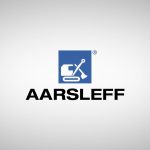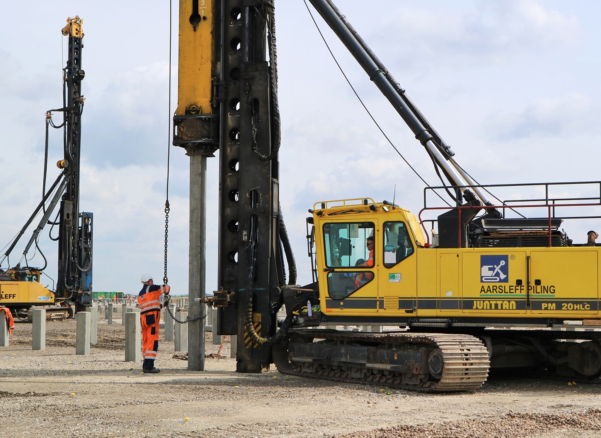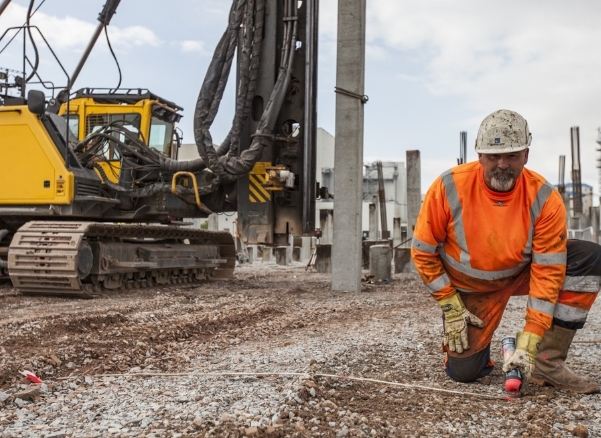Table of Contents
- About Sheet Piling
- Where is Sheet Piling Used?
- Types of Sheet Piles
- Sheet Pile Design
- How are Sheet Piles Installed?
- Are Sheet Piles Watertight?
- Advantages of Sheet Piling
- Disadvantages of Sheet Piling
About Sheet Piling
Sheet piling is an effective groundwork technique commonly used in the UK construction and civil engineering industry. This technique involves driving multiple narrow sheets of angular material into the ground to create a retaining barrier or wall for earth retention and lateral earth support. Sheet piles are typically made of metal, primarily steel, but they can also be made of timber, vinyl or precast concrete. Selecting the right sheet piling material and design depends on many specific factors including the type of work being carried out, site conditions, the nature of the structure, water levels and the required depth of sheet piles. [1]
Steel sheet piles are designed with interlocking edges for easy and efficient installation. This interlocking design is known as Larssen sheet piling. The concept of Larssen sheet piling was invented in the early 20th century by Tryggve Larssen, a Norwegian engineer. [2]
Continue reading to discover more about sheet piling.

Where is Sheet Piling Used?
Sheet piling can be used for various construction and civil engineering projects including building foundations, retaining walls and underground structures such as car parks, pump houses and basements. Other applications include coastal protection and marine structures such as cofferdams, seawalls and canals.
Permanent retaining walls utilising sheet piles are used on schemes large and small, from simple projects to complex slope stabilisation solutions. They may be designed to both retain temporary works and to act as the permanent retaining structure, often in conjunction with the base slab which offers propping to the wall.
Sheet pile walls are also commonly used in service yards of commercial and retail sector developments, flood defence schemes, bridge abutments and boundary walls.
Types of Sheet Piles
The different types of sheet piles include:
- Wooden sheet piles
- Wakefield piles
- Steel sheet piles
- Precast concrete sheet piles
- Light-gauge aluminium sheet piles
- Vinyl sheet piles
- Fibreglass sheet piles
- Cantilever sheet piles
Cantilever sheet piles are walls that do not have any supports and thus have a free, unsupported excavation. Cantilever walls restrain retained earth by the passive resistance provided by the soil below the excavation.
Sheet Pile Design
The design of the wall will determine how long the sheet piled wall can last. Sheet piled walls can be constructed to have a design life of 120 years.
Sheet piles are available in three main designs or shapes: Z-shaped, U-shaped and straight web sections.
U-Shaped
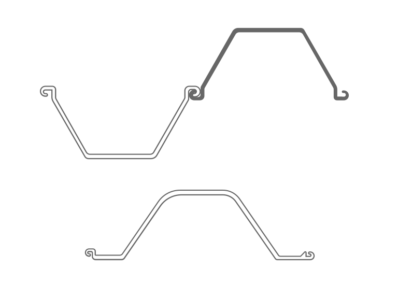
U-shaped sheet piles can be easily stacked. They are more resistant to bending, which makes them more suitable for temporary structures.
Z-Shaped

Z-shaped sheet piles are considered the most efficient shape. Their section modulus to weight ratio and their resistance to bending is higher compared to U-shaped sheet piles.
Straight Web Sections

Straight web sections are used to interlock and form circular or enclosed structures. They are generally backfilled with earth or gravel.
How are sheet piles installed?
Before installation, the ground is inspected for stability and the sheet piles are inspected for cracks or any other damage. Sheet piles are generally driven or hammered into the ground using a telescopic leader rig with a vibratory hammer or an impact hammer, if the ground is too hard or dense. However, these traditional methods produce high frequencies of noise and vibration.
For environmentally sensitive areas or sites that require lower levels of noise or vibration, sheet piles are installed using a hydraulic silent press, which is noise and vibration-free. The pile press equipment essentially ‘walks’ along the pile heads, using a self-moving system. This means no crane support is required to move the pile press along the line of the wall, allowing its employment in locations traditionally difficult to reach, such as by water.
This video demonstrates the installation of pressed sheet piles using a hydraulically powered static load press-in method:
For difficult soil conditions that contain larger particles, driving assistance may need to be considered. One example of driving assistance is water jetting. A high-powered water jet is attached at the toe of the sheet pile and uses low pressure to push the particles out of the way, allowing the pile to be easily inserted into the ground.
Are Sheet Piles Watertight?
A sealing system provides a cost-effective solution to control water seepage through the wall, for instance, to minimise the risk of settlement of adjacent property or keep excavations dry.
The water tightness of ArcelorMittal or Larssen interlocks invariably improves with time, but a sealant provides a means by which the flow of water can be controlled faster and more reliably.
The water flow through sealed interlocks can be calculated with a practical design method backed up by several in-situ full-scale tests.
Each construction project is unique because of ground conditions, water tightness requirements, installation methods and vary from site to site. Therefore, the choice of a sealing system must be made carefully considering all the environmental constraints and requirements.
The integrity of a sealant will depend upon its suitability regarding the installation and the driving method, as well as the soil and water conditions.
e. Therefore, the choice of a sealing system must be made carefully considering all the specific constraints and requirements.
The integrity of a sealant will depend upon its suitability regarding the installation and the driving method, as well as the soil and water conditions.
Advantages of sheet piling
There are many advantages of sheet piling, these include:
- Versatile – Sheet piling can be used for both temporary or permanent works and is suitable for a wide range of soils. Sheet piles are available in different sizes and steel grades. Furthermore, steel sheet piles can be welded or bolted together to create the desired length or depth.
- Durable – Sheet piling has a lifespan of up to 125 years. Steel sheet piles are extremely durable, provide long-lasting performance and can withstand harsh environments.
- Cost & Time-Effective – Sheet piles are relatively easy to install, maintain and extract. This leads to saving time and reducing labour costs. They also offer cost-effective alternatives to contiguous and secant piled walls.
- Watertight – For marine applications, sheet piles can be secured or welded to ensure a watertight barrier, allowing no water to pass through.
- Anti-corrosive – Sheet piles can be sprayed with an anti-corrosive coating to prevent corrosion and enhance their lifespan.
- Minimal Disruption – Sheet piling solutions do not cause disruption or damage to the surrounding ground, unlike other techniques such as bored piling or contiguous piling.
- Sustainable – Steel sheet piles are recyclable and reusable, making them a sustainable option. [3]
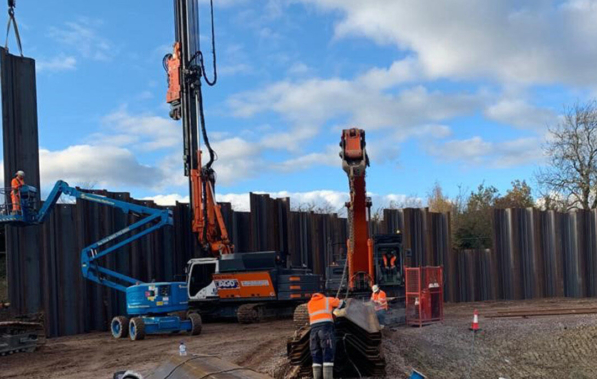
Disadvantages of sheet piling
The disadvantages of sheet piling include:
- In rocky soils and challenging conditions, such as large boulders, sheet piles can rarely be driven to the desired depth.
- Sheet piling typically requires heavy equipment to install.
- If not installed and handled carefully, sheet piles will deviate relatively quickly during driving.
There are a number of alternative retaining wall solutions. King Post Walls, for example, are a cheaper alternative to sheet piling if concrete infill panels are chosen.
Sources
- 1. Design Buildings. (2022). Sheet Piles. Retrieved 17th July 2024, from
https://www.designingbuildings.co.uk/wiki/Sheet_piles#Steel_sheet_piles - 2. Wikipedia. (2022). Larssen Sheet Piling. Retrieved 17th July 2024, from
https://en.wikipedia.org/wiki/Larssen_sheet_piling - 3. Design Buildings. (2020). All You Need to Know About Sheet Piling. Retrieved 17th July 2024, from
https://www.designingbuildings.co.uk/wiki/All_you_need_to_know_about_sheet_piling
